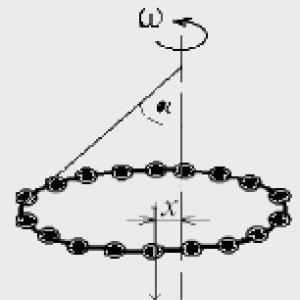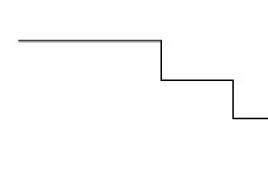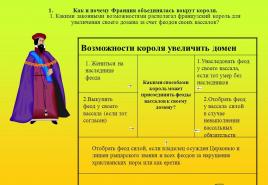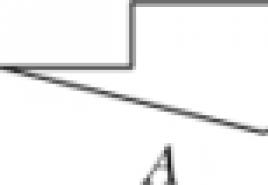Technical mechanics theoretical mechanics of dynamics. Solving problems in theoretical mechanics
Point kinematics.
1. The subject of theoretical mechanics. Basic abstractions.
Theoretical mechanicsis a science in which general laws are studied mechanical movement and mechanical interaction of material bodies
Mechanical movement is called the movement of a body in relation to another body that occurs in space and time.
Mechanical interaction such an interaction of material bodies is called that changes the nature of their mechanical motion.
Statics - This is a branch of theoretical mechanics, in which methods of transforming systems of forces into equivalent systems are studied and conditions for the equilibrium of forces applied to a solid are established.
Kinematics - this is a branch of theoretical mechanics that studies the movement of material bodies in space from a geometric point of view, regardless of the forces acting on them.
Dynamics - this is a section of mechanics, which studies the movement of material bodies in space, depending on the forces acting on them.
Objects of study in theoretical mechanics:
material point,
system of material points,
Absolutely solid.
Absolute space and absolute time are independent of one another. Absolute space - three-dimensional, homogeneous, fixed Euclidean space. Absolute time - flows from the past to the future continuously, it is homogeneous, the same at all points in space and does not depend on the movement of matter.
2. The subject of kinematics.
Kinematics - this is a branch of mechanics in which the geometric properties of the motion of bodies are studied without taking into account their inertia (i.e. mass) and the forces acting on them
To determine the position of a moving body (or point) with the body, in relation to which the movement of the given body is being studied, some coordinate system is rigidly connected, which together with the body forms frame of reference.
The main task of kinematics is to, knowing the law of motion of a given body (point), determine all kinematic quantitiesthat characterize its movement (speed and acceleration).
3. Methods for specifying point movement
· Natural way
It should be known:
Point motion trajectory;
Start and direction of counting;
The law of motion of a point along a given trajectory in the form (1.1)
· Coordinate way
Equations (1.2) are the equations of motion of the point M.
The trajectory equation of point M can be obtained by excluding the time parameter « t » from equations (1.2)
· Vector way
|
|
(1.3) Relationship between coordinate and vector ways of specifying point movement
|
The relationship between coordinate and natural ways of specifying point movement
Determine the trajectory of a point, excluding time from equations (1.2);
-- find the law of motion of a point along a trajectory (use the expression for the differential of the arc)
After integration, we obtain the law of motion of a point along a given trajectory:
The relationship between the coordinate and vector methods of specifying the motion of a point is determined by the equation (1.4)
4. Determination of the speed of a point in the vector method of specifying motion.
Let the moment in timetthe position of the point is determined by the radius vector, and at the moment of timet 1
- radius vector, then for a period of time ![]() the point will move.
the point will move.
|
|
average point speed, the vector is directed as well as the vector
|
Point speed at a given time
To get the speed of a point at a given time, it is necessary to make the passage to the limit
 (1.6)
(1.6)
(1.7)
The velocity vector of a point at a given time is equal to the first time derivative of the radius vector and is directed tangentially to the trajectory at a given point.
(unit¾ m / s, km / h)
Average acceleration vector has the same direction as the vectorΔ v , that is, directed towards the concavity of the trajectory.
Acceleration vector of a point at a given time is equal to the first derivative of the velocity vector or the second derivative of the radius vector of the point with respect to time.
(unit of measure -)
How is the vector positioned in relation to the path of the point?
When straight motion the vector is directed along the straight line along which the point moves. If the trajectory of a point is a flat curve, then the acceleration vector, as well as the vector cp, lies in the plane of this curve and is directed towards its concavity. If the trajectory is not a plane curve, then the vector cp will be directed towards the concavity of the trajectory and will lie in the plane passing through the tangent to the trajectory at the pointM and a straight line parallel to the tangent at an adjacent pointM 1 . IN limit when pointM 1 strives for M this plane occupies the position of the so-called contacting plane. Therefore, in the general case, the acceleration vector lies in the contacting plane and is directed towards the concavity of the curve.
ContentKinematics
Material point kinematics
Determination of the speed and acceleration of a point according to the given equations of its motion
Given: Equations of motion of a point: x \u003d 12 sin (πt / 6), cm; y \u003d 6 cos 2 (πt / 6), cm.
Set the type of its trajectory and for the time moment t \u003d 1 sec find the position of a point on the trajectory, its speed, total, tangential and normal accelerations, as well as the radius of curvature of the trajectory.
Translational and rotational motion of a rigid body

Given:
t \u003d 2 s; r 1 \u003d 2 cm, R 1 \u003d 4 cm; r 2 \u003d 6 cm, R 2 \u003d 8 cm; r 3 \u003d 12 cm, R 3 \u003d 16 cm; s 5 \u003d t 3 - 6t (cm).
Determine at time t \u003d 2 the speeds of points A, C; angular acceleration of wheel 3; point B acceleration and staff acceleration 4.
Kinematic analysis of a flat mechanism

Given:
R 1, R 2, L, AB, ω 1.
Find: ω 2.

The flat mechanism consists of rods 1, 2, 3, 4 and slide E. The rods are connected by means of cylindrical hinges. Point D is located in the middle of bar AB.
Given: ω 1, ε 1.
Find: the speeds V A, V B, V D and V E; angular velocities ω 2, ω 3 and ω 4; acceleration a B; angular acceleration ε AB link AB; positions of instant centers of speeds P 2 and P 3 of links 2 and 3 of the mechanism.
Determination of absolute speed and absolute point acceleration

The rectangular plate rotates around a fixed axis according to the law φ \u003d 6 t 2 - 3 t 3 ... The positive direction of reading the angle φ is shown in the figures with an arc arrow. Rotation axis OO 1 lies in the plane of the plate (the plate rotates in space).
Point M moves along the line BD on the plate. The law of its relative motion is given, i.e., the dependence s \u003d AM \u003d 40 (t - 2 t 3) - 40 (s - in centimeters, t - in seconds). Distance b \u003d 20 cm... In the figure, point M is shown in a position at which s \u003d AM > 0 (for s< 0 point M is on the other side of point A).
Find the absolute speed and absolute acceleration of point M at time t 1 \u003d 1 s.
Dynamics
Integration of differential equations of motion of a material point under the action of variable forces
A load D of mass m, having received the initial velocity V 0 at point A, moves in a curved pipe ABC located in a vertical plane. On the section AB, the length of which is l, a constant force T (its direction is shown in the figure) and the resistance force R of the medium act on the load (the modulus of this force R \u003d μV 2, the vector R is directed opposite to the speed V of the load).
The load, having finished its movement on section AB, at point B of the pipe, without changing the value of its velocity modulus, goes to section BC. In section BC, a variable force F acts on the load, the projection F x of which on the x axis is given.
Considering the load as a material point, find the law of its movement on the BC section, i.e. x \u003d f (t), where x \u003d BD. Disregard the friction of the load on the pipe.

Download problem solution
The theorem on the change in the kinetic energy of a mechanical system
The mechanical system consists of weights 1 and 2, a cylindrical roller 3, two-stage pulleys 4 and 5. The bodies of the system are connected by threads wound on the pulleys; the thread sections are parallel to the corresponding planes. The roller (solid uniform cylinder) rolls on the reference plane without sliding. The radii of the steps of the pulleys 4 and 5 are, respectively, R 4 \u003d 0.3 m, r 4 \u003d 0.1 m, R 5 \u003d 0.2 m, r 5 \u003d 0.1 m. The mass of each pulley is considered uniformly distributed along its outer rim ... The support planes of weights 1 and 2 are rough, the sliding friction coefficient for each load is f \u003d 0.1.
Under the action of the force F, the modulus of which changes according to the law F \u003d F (s), where s is the displacement of the point of its application, the system starts moving from a state of rest. When the system moves, resistance forces act on the pulley 5, the moment of which relative to the axis of rotation is constant and equal to M 5.
Determine the value of the angular velocity of the pulley 4 at that moment in time when the displacement s of the point of application of the force F becomes equal to s 1 \u003d 1.2 m. 
Download problem solution
Application of the general equation of dynamics to the study of the motion of a mechanical system
For the mechanical system, determine the linear acceleration a 1. Assume that the masses of blocks and rollers are distributed along the outer radius. Cables and belts are considered weightless and inextensible; there is no slippage. Neglect rolling and sliding friction. 
Download problem solution
Application of the d'Alembert principle to the determination of the reactions of the supports of a rotating body
Vertical shaft AK, rotating uniformly with an angular velocity ω \u003d 10 s -1, is fixed by a thrust bearing at point A and a cylindrical bearing at point D.
A weightless rod 1 with a length of l 1 \u003d 0.3 m is rigidly attached to the shaft, at the free end of which there is a load with a mass of m 1 \u003d 4 kg, and a homogeneous rod 2 with a length of l 2 \u003d 0.6 m and a mass of m 2 \u003d 8 kg. Both rods lie in the same vertical plane. The points of attachment of the rods to the shaft, as well as the angles α and β, are indicated in the table. Dimensions AB \u003d BD \u003d DE \u003d EK \u003d b, where b \u003d 0.4 m. Take the load as a material point.
By neglecting the mass of the shaft, determine the reaction of the thrust bearing and bearing.

20th ed. - M .: 2010.- 416 p.
The book outlines the basics of the mechanics of a material point, a system of material points and solid in the amount corresponding to the programs of technical universities. There are many examples and problems, the solutions of which are accompanied by appropriate methodological instructions. For students of full-time and part-time technical universities.
Format: pdf
The size: 14 Mb
Watch, download: drive.google
TABLE OF CONTENTS
Preface to Thirteenth Edition 3
Introduction 5
SECTION ONE STATIC SOLID BODY
Chapter I. Basic concepts background provisions of Articles 9
41. Absolutely solid; force. Static problems 9
12. Initial positions of statics "11
$ 3. Relationships and their reactions 15
Chapter II. The addition of forces. System of converging forces 18
§four. Geometrically! The way of adding forces. Resultant of converging forces, decomposition of forces 18
f 5. Projections of the force on the axis and on the plane, Analytical method of setting and adding forces 20
16. Equilibrium of the system of converging forces_. ... ... 23
17. Solving problems of statics. 25
Chapter III. The moment of force relative to the center. A pair of forces 31
i 8. Moment of force relative to the center (or point) 31
| 9. A couple of forces. Couple moment 33
f 10 *. Equivalence and pair addition theorems 35
Chapter IV. Bringing the system of forces to the center. Equilibrium conditions ... 37
f 11. Theorem on parallel force transfer 37
112. Bringing the system of forces to this center -. , 38
§ 13. Conditions of equilibrium of the system of forces. The resultant moment theorem 40
Chapter V. Flat system of forces 41
§ 14. Algebraic moments of force and pairs 41
115. Bringing a flat system of forces to the simplest form .... 44
§ 16. Equilibrium of a plane system of forces. The case of parallel forces. 46
§ 17. Solving problems 48
118. Equilibrium of systems of bodies 63
§ 19*. Statically definable and statically indeterminate systems of bodies (structures) 56 "
f 20 *. Defining internal efforts. 57
§ 21 *. Distributed forces 58
E22 *. Calculation of flat trusses 61
Chapter VI. Friction 64
! 23. Laws of sliding friction 64
: 24. Reactions of rough bonds. Friction angle 66
: 25. Equilibrium in the presence of friction 66
(26 *. Friction of a thread on a cylindrical surface 69
1 27 *. Rolling friction 71
Chapter VII. Spatial Force System 72
§28. The moment of force about the axis. Calculation of the principal vector
and the main moment of the system of forces 72
§ 29 *. Reducing the spatial system of forces to the simplest form 77
§thirty. Equilibrium of an arbitrary spatial system of forces. Parallel Forces Case
Chapter VIII. Center of gravity 86
§31. Center of Parallel Forces 86
§ 32. Force field. Center of gravity of rigid body 88
§ 33. Coordinates of the centers of gravity of homogeneous bodies 89
§ 34. Methods for determining the coordinates of the centers of gravity of bodies. 90
§ 35. Centers of gravity of some homogeneous bodies 93
SECTION TWO KINEMATICS OF A POINT AND SOLID BODY
Chapter IX. Point kinematics 95
§ 36. Introduction to kinematics 95
§ 37. Methods of specifying the movement of a point. ... 96
§38. Point velocity vector ,. 99
§ 39. The vector of "cutting point 100
§40. Determination of the speed and acceleration of a point in the coordinate method of setting motion 102
§41. Solving the problems of kinematics point 103
§ 42. Axes of the natural trihedron. Numerical value of speed 107
§ 43. Tangent and normal acceleration of point 108
§44. Some special cases of movement of the PO point
§45. Point 112 movement, speed and acceleration graphs
§ 46. Problem solving< 114
§47 *. Point velocity and acceleration in polar coordinates 116
Chapter X. Translational and rotational motion of a rigid body. ... 117
§48. Translational motion 117
§ 49. Rotational motion of a rigid body around an axis. Angular velocity and angular acceleration 119
§fifty. Uniform and equal rotation 121
§51. Speeds and accelerations of points of a rotating body 122
Chapter XI. Plane-parallel movement of a rigid body 127
§52. Equations of plane-parallel motion (motion of a plane figure). Decomposition of motion into translational and rotational 127
§53 *. Defining trajectories of points of a flat figure 129
§54. Determination of the velocities of points of a flat figure 130
§ 55. A theorem on the projections of the velocities of two points of a body 131
§ 56. Determination of the speeds of points of a flat figure using the instantaneous center of speeds. Understanding centroids 132
§57. Problem solving 136
§58 *. Determining the acceleration of points of a flat figure 140
§59 *. Instant acceleration center "*" *
Chapter XII *. The movement of a rigid body around a fixed point and the movement of a free rigid body 147
§ 60. Motion of a rigid body having one fixed point. 147
§61. Euler's Kinematic Equations 149
§62. Speeds and accelerations of body points 150
§ 63. The general case of motion of a free rigid body 153
Chapter XIII. Difficult Point Movement 155
§ 64. Relative, figurative and absolute motion 155
§ 65, The theorem on the addition of velocities "156
§66. The theorem on the addition of accelerations (Coriolns' theorem) 160
§67. Problem solving 16 *
Chapter XIV *. Complex motion of a rigid body 169
§68. Addition translational movements 169
§69. Adding Rotations Around Two Parallel Axes 169
§70. Spur gears 172
§ 71. Addition of rotations around intersecting axes 174
§72. Addition of translational and rotational movements. Screw movement 176
SECTION THREE POINT DYNAMICS
Chapter XV: Introduction to Dynamics. The laws of dynamics 180
§ 73. Basic concepts and definitions 180
§ 74. The laws of dynamics. Problems of the dynamics of a material point 181
Section 75. Systems of units 183
§76. Basic forces 184
Chapter XVI. Differential equations of motion of a point. Solving point dynamics problems 186
§ 77. Differential equations, motion of a material point No. 6
§ 78. Solution of the first problem of dynamics (determination of forces for a given motion) 187
§ 79. Solution of the main problem of dynamics for rectilinear motion of a point 189
§ 80. Examples of solving problems 191
§81 *. The fall of the body in a resisting environment (in the air) 196
§82. Solution of the main problem of dynamics, with curvilinear motion of a point 197
Chapter XVII. General theorems of point dynamics 201
§83. The amount of point movement. Force Impulse 201
§ S4. The theorem on the change in the momentum of a point 202
§ 85. The theorem on the change in the angular momentum of a point (the theorem of moments) "204
§86 *. Movement under the influence of a central force. The law of areas .. 266
§ 8-7. Work of strength. Power 208
§88. Examples of calculating work 210
§89. Theorem about the change in the kinetic energy of a point. "... 213J
Chapter XVIII. Not free and relative to the movement of a point 219
§90. Non-free movement of a point. 219
§91. Relative point movement 223
§ 92. The influence of the Earth's rotation on the balance and motion of bodies ... 227
§ 93 *. Deviation of the falling point from the vertical due to the rotation of the Earth "230
Chapter XIX. Rectilinear point vibrations. ... ... 232
§ 94. Free vibrations without taking into account the forces of resistance 232
§ 95. Free vibrations with viscous resistance (damped vibrations) 238
§96. Forced vibrations. Rezonayas 241
Chapter XX *. Body movement in the gravitational field 250
§ 97. The motion of a thrown body in the gravitational field of the Earth "250
§98. Artificial satellites Earth. Elliptical trajectories. 254
§ 99. The concept of weightlessness. "Local frames of reference 257
SECTION FOUR SYSTEM AND SOLID BODY DYNAMICS
Chapter XXI. Introduction to system dynamics. Moments of inertia. 263
§ 100. Mechanical system. External forces and internal forces 263
§ 101. The mass of the system. Center of gravity 264
§ 102. Moment of inertia of a body about an axis. Radius of gyration. ... 265
$ 103. Moments of inertia of a body relative to parallel axes. Huygens' theorem 268
§ 104 *. Centrifugal moments of inertia. Concepts about the main axes of inertia of a body 269
$ 105 *. The moment of inertia of a body about an arbitrary axis. 271
Chapter XXII. The theorem on the motion of the center of mass of a system 273
$ 106. Differential equations of motion of the system 273
§ 107. The theorem on the motion of the center of mass 274
$ 108. Law of conservation of motion of the center of mass 276
§ 109. Problem solving 277
Chapter XXIII. The theorem on the change in the number of movable systems. ... 280
$ BUT. System movement amount 280
§111. Momentum Change Theorem 281
§ 112. Law of conservation of momentum 282
$ 113 *. Application of the theorem to the motion of a liquid (gas) 284
§ 114 *. Body of variable mass. Rocket movement 287
Gdava XXIV. Theorem on the change in the moment of quantities of motion of the system 290
§ 115. The main moment of the quantities of motion of the system 290
$ 116. The theorem on the change of the main moment of the quantities of motion of the system (the theorem of moments) 292
$ 117. The law of conservation of the main moment of the quantities of motion. ... 294
$ 118. Problem solving 295
$ 119 *. Application of the theorem of moments to the motion of a liquid (gas) 298
§ 120. Conditions of equilibrium of a mechanical system 300
Chapter XXV. Theorem about the change in the kinetic energy of the system. ... 301.
§ 121. Kinetic energy of the system 301
$ 122. Some Cases of Calculating Work 305
$ 123. The theorem on the change in the kinetic energy of the system 307
$ 124. Problem solving 310
$ 125 *. Mixed problems "314
$ 126. Potential Force Field and Force Function 317
$ 127, Potential Energy. Mechanical energy conservation law 320
Chapter XXVI. "Application of general theorems to rigid body dynamics 323
$ 12 &. Rotational motion of a rigid body around a fixed axis ". 323"
$ 129. Physical pendulum... Experimental determination of the moments of inertia. 326
$ 130. Plane-parallel motion of a rigid body 328
$ 131 *. Elementary gyroscope theory 334
$ 132 *. Motion of a rigid body around a fixed point and motion of a free rigid body 340
Chapter XXVII. D'Alembert Principle 344
$ 133. D'Alembert principle for a point and a mechanical system. ... 344
$ 134. Main vector and main moment of inertia forces 346
$ 135. Problem solving 348
$ 136 *, Didemic reactions acting on the axis of a rotating body. Balancing non-rotating bodies 352
Chapter XXVIII. The principle of possible displacements and the general equation of dynamics 357
§ 137. Classification of ties 357
§ 138. Possible movements of the system. The number of degrees of freedom. ... 358
Section 139. The principle of possible movements 360
§ 140. Problem solving 362
Section 141. General equation speakers 367
Chapter XXIX. Equilibrium conditions and equations of motion of the system in generalized coordinates 369
§ 142. Generalized coordinates and generalized velocities. ... ... 369
Section 143. Generalized forces 371
§ 144. Equilibrium conditions of the system in generalized coordinates 375
§ 145. Lagrange's equations 376
§ 146. Problem solving 379
Chapter XXX *. Small fluctuations of the system about a stable equilibrium position 387
§ 147. The concept of stability of equilibrium 387
§ 148. Small free vibrations of a system with one degree of freedom 389
§ 149. Small damped and forced oscillations of a system with one degree of freedom 392
§ 150. Small combined oscillations of a system with two degrees of freedom 394
Chapter XXXI. Elementary Impact Theory 396
§ 151. The basic equation of the theory of impact 396
§ 152. General theorems of the theory of impact 397
§ 153. Coefficient of recovery on impact 399
§ 154. Impact of the body against a fixed obstacle 400
§ 155. Direct central blow of two bodies (blow of balls) 401
§ 156. Loss of kinetic energy at inelastic impact of two bodies. Carnot's theorem 403
§ 157 *. A blow to a rotating body. Impact center 405
Index 409



 (1.5)
(1.5)






